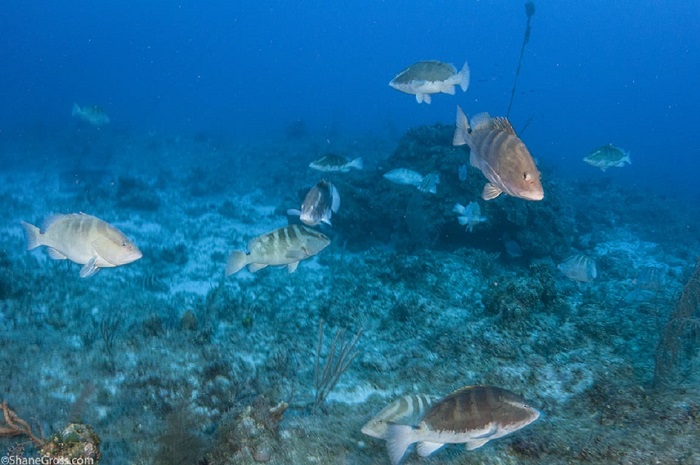By Dr. Karlisa Callwood, Director of PIMS’s Community Conservation Education and Action Program
A new research study finds evidence of population sub-structuring of Nassau grouper within The Bahamas. The study, published in Frontiers in Marine Science, coupled high resolution genetic testing with acoustic telemetry to gain additional insight into the population structure and demographics of Nassau grouper.
Nassau grouper are economically and culturally important in The Bahamas. Yet globally, their populations are in decline and the species has been designated by the IUCN (International Union for Conservation of Nature) as critically endangered. Nassau grouper are inherently vulnerable to population declines, due in part to spawning behavior where individuals gather at predictable locations and times each year to reproduce. Known as fish spawning aggregations (FSAs), these annual, lunar-associated events, created by the migration of hundreds to thousands of individuals to one area, make the species increasingly vulnerable to overfishing. As a result, many of the Nassau grouper FSAs identified and historically fished within The Bahamas have been drastically reduced or completely wiped out. In order to effectively manage this species, an understanding of spawning stock sizes, migration patterns to and from FSAs and genetic health of remaining stocks is critical.
To investigate genetic variation throughout The Bahamas, researchers compared 96 DNA samples from Nassau grouper across 8 islands in The Bahamas (Abaco, Andros, New Providence, Eleuthera, Exuma, Long Island, Ragged Island, and Great Inagua) and the Hail Mary FSA located in the central Bahamas. RAD sequencing (RAD-seq), a technique used to easily sequence large genomes, was used to identify differences in single-nucleotide polymorphisms (SNPs). SNPs are a type of change in the genetic code in which one base is substituted for another, i.e. a location in the genetic code that can be different for many individuals. Identifying these types of changes can help to reveal fine-scale genetic population structure and detect genes that may contribute to adaptations to different environmental variables.

Acoustic telemetry is a technique used to collect information about fish migration patterns and habitat use. To facilitate this, 103 Nassau grouper were externally tagged, 43 of which were implanted with acoustic transmitters. Data from these transmitters were recorded on 11 acoustic receivers placed throughout the Exumas, Long Island, and the Hail Mary FSA to identify the Nassau grouper using the Hail Mary FSA and examine their migratory patterns across consecutive spawning seasons from 2014 to 2017.

Some of the key research findings include the following:
- Multiple processes influence the spatial dynamics of Nassau grouper.
- There were subtle differences in gene flow among Nassau grouper from the Exumas and Long Island as compared to Nassau grouper from other islands and additional research is necessary to fully understand the patterns of gene flow throughout the entire archipelago.
- Outlier SNPs were correlated with environmental factors including maximum sea surface temperature, maximum current, minimum primary productivity, and salinity.
- The study confirmed long-range dispersal of adult Nassau grouper during the spawning season, as well as the relative contribution of individuals from the Exuma Cays Land and Sea Park (a no-take marine protected area (MPA)) to the Hail Mary FSA.
This research highlights the importance of understanding the reproductive output of active FSAs, as well as Nassau grouper connectivity, in order to design effective MPAs and MPA networks that will help to meet conservation goals for the species. Dr. Krista Sherman of the Perry Institute of Marine Science (PIMS), lead researcher on the project, says, “Our findings highlight the need for better management and enforcement of fisheries regulations to protect Nassau grouper around the Exumas and Long Island to maintain both genetic stocks as they appear to be different from other islands. We were able to uncover new information about the connectivity of Nassau grouper within the Exuma Sound as well as identify the processes that may be involved in shaping these patterns. This not only provides directions for future research, but also gives us the opportunity to monitor and evaluate the effectiveness of conservation strategies for maintaining healthy populations of Nassau grouper within the country”.
The study, “RAD-Seq Analysis and in situ Monitoring of Nassau Grouper Reveal Fine-Scale Population Structure and Origins of Aggregating Fish,” was conducted by a research team including scientists from PIMS, the University of Exeter, Shedd Aquarium, Bahamas National Trust, and Field Lab Consulting.
For more information about Nassau grouper and other Fisheries Research & Conservation Program efforts at PIMS, visit perryinstitute.org.
Press Coverage:
ZNS
The Bahamas Weekly
Bahamas Local

